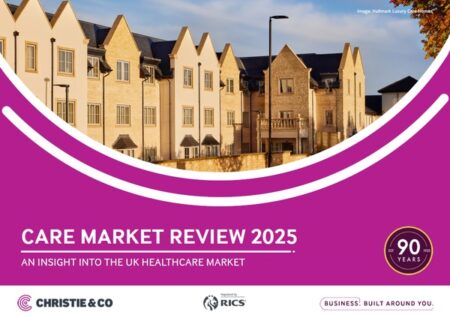UK care home deals hit record high
Specialist business property adviser, Christie & Co, has launched its Care Market Review 2025 report, which analyses a range of topics relating to the UK healthcare business market, including capital markets, land, and development, the transactional market, shifts in local authority fee rates, operator sentiment, the finance landscape, and a Q&A with Jatin Wouhra, Robert Kilgour, and Oona Goldsworthy

Richard Lunn
CAPITAL MARKETS
Healthcare remains a compelling investment due to strong demographic drivers, particularly the ageing population and rising life expectancy, with the over-80s population expected to more than double by 2050.
Investor interest is further supported by ESG credentials and inflation-linked, long-income lease structures.
The 12 months to July 2025 marked a period of strategic realignment amid ongoing macroeconomic and geopolitical shifts, with the market evolving via increased M&A, joint ventures, and a growing focus on management contracts.
Overseas capital significantly boosted deal activity during this time, with sector-specialist REITs like Welltower and Omega leading major acquisitions, including Care UK and 45 Four Seasons care homes (led by Christie & Co), respectively.
H1 2025 also saw robust investor activity, including notable M&A deals like Care Trust REIT’s acquisition of Care REIT plc and the Aedifica-Cofinimmo merger.
While operators are increasingly using lease-based models and sale-and-leaseback structures to unlock capital, looking ahead Christie & Co expects to see more investors exploring sale and manage-back models, offering higher returns with greater operational exposure.
And, as we enter the latter part of 2025, the needs-driven fundamentals are stronger than ever, with an increasing number of European/overseas funds actively evaluating opportunities in the UK alongside the established base of current investors, with the range of funding options available likely to increase.
LAND AND DEVELOPMENT
The UK care home development sector continues to face a complex and unpredictable planning environment, hindered by under-resourced local authorities and evolving policies like Nitrate Neutrality and Biodiversity Net Gain, though Labour’s pledge to recruit 300 planning officers offers hope for medium-term improvement.
Due to planning delays, fully-consented sites remain scarce, despite rising demand driven by an ageing population that is forecast to exceed 16 million people aged 65 and over within a decade.
Developers are increasingly forming joint ventures to share risk and reward, while operators adopt more-efficient spatial standards (50-52sq m per resident) and value-engineered designs to offset high costs.
Larger schemes – now averaging over 70 beds – are gaining traction due to economies of scale, and ESG considerations remain central, with high BREEAM ratings sought to ensure energy efficiency.
While many SME operators paused acquisitions post pandemic, cost stabilisation and improved trading conditions have reignited interest, leading to strong competition for prime, consented sites, and a record H1 2025 in care home land transactions at Christie & Co.
Forward-funding structures are also returning to the sector with more prevalence, and such deal volumes are expected to increase over the next year.
Although elevated costs have pressured land prices, improved operating performance and valuations have helped maintain land values.
Rising private fee levels and easing inflation have positively impacted EBITDA, and the growing use of leasehold OpCo multiples may drive up WholeCo valuations.
Senior living developments remain subdued due to high build costs and a softer housing market, but signs of recovery are emerging.
Demand for inclusive, futureproof housing with communal amenities is rising, driven by lifestyle changes and longer life expectancy.
Overall, the sector outlook is positive, with expectations of increased deal volumes and development activity over the next 12 months.
TRANSACTIONAL ANALYSIS
Christie & Co’s report goes on to analyse the transactions that it has conducted over the past year.
Deal activity surged, with completions at their highest level, and Christie & Co’s pipeline 24% ahead of where it was in 2024. 49% of deals involved homes with 20-39 beds, while only 17% were for homes over 60 beds.
A notable shift occurred in the profile of homes entering the market, with a rise in smaller care homes (under 20 beds) making up 38% of instructions, an increase from 12% in early 2024.
We have seen extremely-positive market activity throughout the year, as many operators look to grow their portfolios
Larger homes (over 60 beds) comprised just 5% of instructions, down from 15%, reflecting a shortage of purpose-built facilities.
And homes with 20-59 beds accounted for 56% of instructions, down from 73% in 2024.
First-time buyers represented 17% of deals in H1 2025, up from 11% in 2024 and just 4% in 2023.
Small and medium-sized groups (those with 3-19 homes) were the most-active buyers (32% of deals), followed closely by independent operators (those with 1-2 homes) at 31%.
Large groups and corporates saw a decline in activity, accounting for only 20% of deals, down from 36% in 2023.
Homes sold with vacant possession rose to 21% in 2025, up from 13% in 2024.
Of these closed homes, 60% remained in care use, 24% were converted to residential dwellings, and 16% repurposed for other uses.
This high closure rate in the sector is something that Christie & Co expects will continue.
Christie & Co also conducted and analysed a Freedom of Information Act survey, covering all 174 local authorities across England, Wales, and Scotland.
It revealed an average residential fee increase in England of 8.6% compared with 9% in 2023/24.
There were some notable fee rate uplifts in certain local authorities, albeit from a low base level.
The burden on the self-funded client base is likely to rise, with the majority of providers achieving private fee increases of between 5% and 10%, sometimes more.

SENTIMENT SURVEY
In the summer of 2025, Christie & Co reached out to a cross-section of local and regional providers throughout the UK to get their views on a range of topics.
Key findings include:
- Occupancy levels have returned to pre-pandemic highs, with 69% of respondents reporting occupancy above 90%. Those in Wales reported the strongest levels, with 67% noting occupancy over 95% compared with 50% in Scotland and 28% in England
- 68% of respondents reported local authority fee increases of between 0-5%, with 31% saying their local authority fees had increased by 5-10%. Interestingly, 92% of Welsh operators reported local authority fee increases of between 5-10%, compared with only 17% in England
- Private fee rates have risen across all regions, with 67% noting an increase of 5-10%. 14% of providers reported private pay increases in excess of 10%, and 19% reported increases of 0-5%
- 98% of respondents believe that a funding increase of at least 5% is necessary to make social care sustainable. Notably, 53% feel that a 10% or greater uplift is required, highlighting a strong perception that only substantial investment will address current challenges
- 49% of operators have experienced a reduction in agency usage over the last 12 months, whereas only 10% stated agency usage had increased. In Wales, 67% of providers reported no change in agency usage; meanwhile, 14% of Scottish providers reported an increase
- Less than a third of care operators (31%) believe they will be able to offset the cost inflation from NI changes through their 2025/26 fee increases. A larger proportion (44%) say they will not be able to absorb the costs, while 25% remain unsure
- 69% have stalled their growth or investment plans for 2025 due to the recent NI changes, highlighting a significant disruption to sector development
- Whilst ESG is becoming a more-important consideration for investors, only 33% of operators reported having a targeted strategy in place
FINANCE
A segment from Christie Finance on the finance landscape notes that the care sector continues to attract strong interest from the finance market, with both new and established operators seeking debt funding to support growth.
However, securing finance remains challenging due to increasingly-rigorous lender requirements.
Established operators are leveraging existing portfolios to fund acquisitions, preserving cash for capital expenditure, as reflected in a 23% rise in average debt balances.
New entrants face higher investment thresholds, but benefit from increased availability of smaller, first-time buyer homes, with Christie Finance reporting a 24% rise in single asset instructions.
On a recent trip to the USA, investors called this a ‘Goldilocks period’ for senior care providers and investors, with the much-heralded arrival of the huge demographic wave of elderly people requiring care and support and limited quality supply to meet this demand in future years
Demand for debt financing is strong across Christie Finance’s Core (up to £5m) and corporate (over £5m) divisions, with core instructions rising to 69% in H1 2024, driven by smaller operators, and corporate activity remaining robust, with a 50% increase in refinancing from 2023 to 2024.
Real estate services, including bridging and development finance, are also in higher demand.
Operators are increasingly exploring diverse financing options – commercial mortgages, unsecured loans, and asset finance – to upgrade facilities and expand services.
And, as the Bank of England base rate declines, lenders are offering finer margins, though credit processes remain slow due to regulatory complexity.
Richard Lunn, managing director of care at Christie & Co, said: “We have seen extremely-positive market activity throughout the year, as many operators look to grow their portfolios.
“By the end of August, we had already transacted more deals than in 2024, and our forward pipeline is the highest ever, reflecting the investor and operator desire to acquire care services.
“On a recent trip to the USA, investors called this a ‘Goldilocks period’ for senior care providers and investors, with the much-heralded arrival of the huge demographic wave of elderly people requiring care and support and limited quality supply to meet this demand in future years.”
